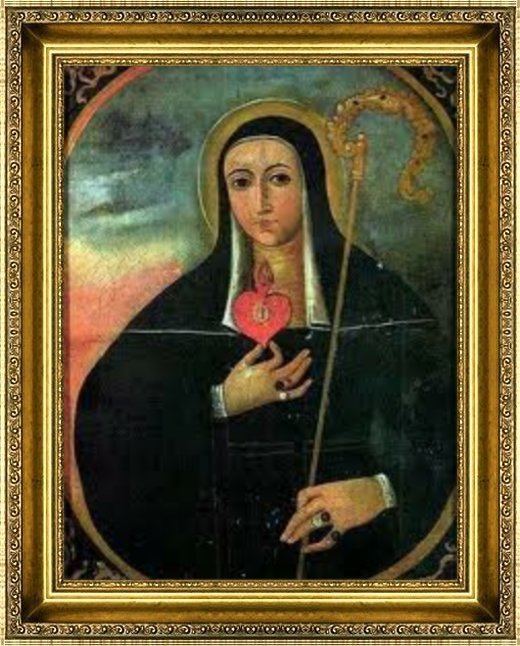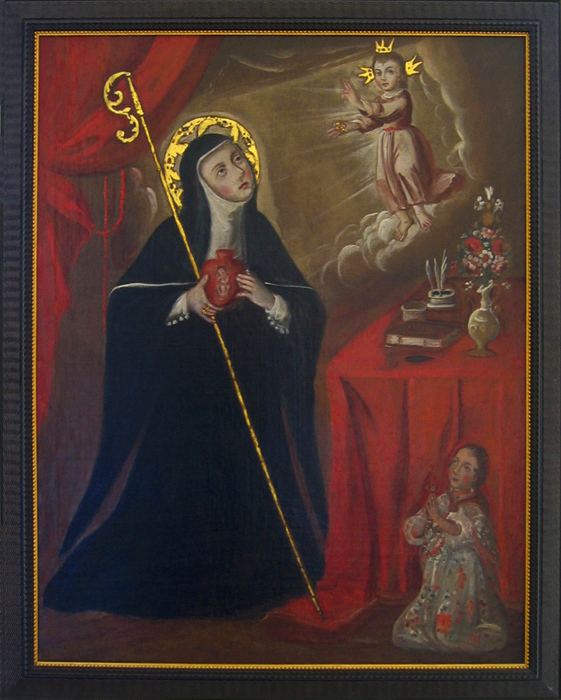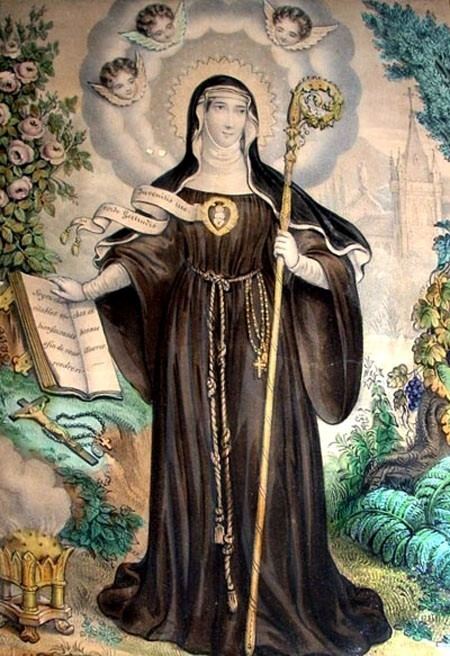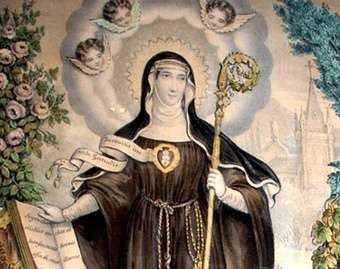Role Saint Name Gertrude Great | Attributes crown, lily, taper Feast November 16 | |
 | ||
Canonized 1677 (equipollently) by Clement XII Books Life and Revelations of Saint G, Spiritual exercises, The Exercises of Saint G, The Herald of God's Loving Ki Similar People Bernard of Clairvaux, Aelred of Rievaulx, Saint Margaret of Scotland | ||
Saint gertrude the great
Gertrude the Great (or Saint Gertrude of Helfta) (Italian: Santa Gertrude) (January 6, 1256 – c. 1302) was a German Benedictine, mystic, and theologian. She is recognized as a saint by the Roman Catholic Church, and is inscribed in the General Roman Calendar, for celebration throughout the Latin Rite on November 16.
Contents
- Saint gertrude the great
- St gertrude the great
- Life
- Works
- Devotion to the Sacred Heart
- Later reputation and influence
- Veneration
- Patronage
- Legacy
- References

St gertrude the great
Life

Little is known of the early life of Gertrude. Gertrude was born on the feast of the Epiphany, January 6, 1256, in Eisleben, Thuringia (within the Holy Roman Empire). At the age of four, she entered the monastery school at the monastery of St. Mary at Helfta (with much debate having occurred as to whether this monastery is best described as Benedictine or Cistercian), under the direction of its abbess, Gertrude of Hackeborn. It is speculated that she was offered as a child oblate to the Church by devout parents. Given that Gertrude implies in the Herald that her parents were long dead at the time of writing, however, it is also possible that she entered the monastery school as an orphan.

Gertrude was confided to the care of St. Mechtilde, younger sister of the Abbess Gertrude, and joined the monastic community in 1266. It is clear from her own writings that she received a thorough education in a range of subjects. She, and the nun who authored Books 1 and 3-5 of the Herald, are thoroughly familiar with scripture, the Fathers of the Church such as Augustine and Gregory the Great, and also in more contemporary spiritual writers such as Richard and Hugh of St Victor, William of St Thierry, and Bernard of Clairvaux. Moreover, Gertrude's writing demonstrates that she was well-versed in rhetoric, and her Latin is very fluent.

In 1281, at the age of twenty-five, she experienced the first of a series of visions that continued throughout her life, and which changed the course of her life. Her priorities shifted away from secular knowledge and toward the study of Scripture and theology. Gertrude devoted herself strongly to personal prayer and meditation, and began writing spiritual treatises for the benefit of her monastic sisters. Gertrude became one of the great mystics of the 13th century. Together with her friend and teacher St. Mechtild, she practiced a spirituality called "nuptial mysticism," that is, she came to see herself as the bride of Christ.

Gertrude died at Helfta, near Eisleben, Saxony, around 1302. Her feastday is celebrated on November 16, but the exact date of her death is unknown; the November date stems from a confusion with Abbess Gertrude of Hackeborn.
Works

Gertrude produced numerous writings, though only some survive today. The longest survival is the Legatus Memorialis Abundantiae Divinae Pietatis (known in English today as The Herald of Divine Love or The Herald of God's Loving-Kindness, and sometimes previously known as Life and Revelations), partly written by other nuns. There also remains her collection of Spiritual Exercises. A work known as Preces Gertrudianae (Gertrudian Prayers) is a later compilation, made up partly of extracts from the writings of Gertrude and partly of prayers composed in her style. It is also very possible that Gertrude was the author of a part of the revelations of Mechthild of Hackeborn, the Book of Special Grace.
The Herald is composed of five books. Book 2 forms the core of the work, and was written by Gertrude herself; she states that she began the work on Maundy Thursday 1289. Books 3, 4, and 5 were written by another nun, or possibly more than one, during Gertrude's lifetime and probably at least in part at her dictation. Book 1 was written shortly before or after Gertrude's death as an introduction to the whole collection; it is possible it was written by Gertrude's confessor, but far more like that the author was another Helfta nun.
The importance of the Spiritual Exercises extends to the present day because they are grounded in themes and rites of Church liturgy for occasions of Baptism, conversion, commitment, discipleship, union with God, praise of God, and preparation for death. Gertrude's Spiritual Exercises can still be used by anyone who seeks to deepen spirituality through prayer and meditation.
Devotion to the Sacred Heart
One of the most esteemed woman saints of the Christian West, she was a notable early devotee of the Sacred Heart of Jesus. Book 2 of the Herald of Divine Love is notable within the history of Christian devotion because its vivid descriptions of Gertrude's visions show a considerable elaboration on the long-standing but ill-defined veneration of Christ's heart. This veneration was present in the belief that Christ's heart poured forth a redemptive fountain through the wound in His side; an image culminating in its most famous articulation by St Bernard in his commentary on the Song of Songs. The women of Helfta—Gertrude foremost, who surely knew Bernard's commentary, and to a somewhat lesser extent the two Mechthilds - Mechthild of Magdeburg and Mechthild of Hackeborn — made this devotion central to their mystical visions. Saint Gertrude had a vision on the feast of John the Evangelist. She was resting her head near the wound in the Savior's side and hearing the beating of the Divine Heart. She asked Saint John if on the night of the Last Supper, he had felt these pulsations, why he had never spoken of the fact. Saint John replied that this revelation had been reserved for subsequent ages when the world, having grown cold, would have need of it to rekindle its love.
Later reputation and influence
After her death, Gertrude's works seem to have vanished almost without trace. Only 5 manuscripts of the Herald have survived, the earliest one being written in 1412, and only two of these manuscripts are complete. With the invention of printing, Gertrude became far more prominent, with Latin, Italian and German editions being published in the sixteenth century. She was popular in seventeenth-century France, where her trust in and burning love for God were potent antidotes to Jansenism.
Philip Neri and Francis de Sales both used her prayers and recommended them to others.
In Spain, Fr Diego, the confessor to Philip II, read the revelations of Gertrude aloud to the king as he lay dying in the Escorial.
Her works were also popular with the Discalced Carmelites in the sixteenth century. Fr Francisco Ribera, the confessor to Teresa of Ávila, recommended her to take Gertrude as spiritual mistress and guide.
More recently, Dom Prosper Guéranger, the restorer of Benedictine monasticism in France, was influenced by Gertrude. His Congregation of Solesmes was responsible for most of the work done on Gertrude in the nineteenth century.
Veneration
Gertrude was never formally canonized, but a liturgical office of prayer, readings, and hymns in her honor was approved by Rome in 1606. The Feast of St. Gertrude was extended to the universal Church by Clement XII and today is celebrated on November 16, the date of her death. Pope Benedict XIV gave her the title "the Great" to distinguish her from Abbess Gertrude of Hackeborn and to recognize the depth of her spiritual and theological insight.
Gertrude showed "tender sympathy towards the souls in purgatory" and urged prayers for them. She is therefore invoked for suffering souls in purgatory. The following prayer is attributed to St. Gertrude, and is often depicted on her Prayer card:
Perhaps for that reason, her name has been attached to a prayer that, according to a legend of uncertain origin and date (neither are found in the Revelations of Saint Gertrude the Great), Christ promised to release a thousand souls from purgatory each time it was said; despite the fact that practices relative to alleged promises to free one or more souls from purgatory by the recitation of some prayer were prohibited by Pope Leo XIII.
Patronage
In compliance with a petition from King Philip IV of Spain she was declared Patroness of the West Indies; in Peru her feast is celebrated with great pomp, and in New Mexico the town Santa Gertrudis de lo de Mora was built in her honour and bears her name.
